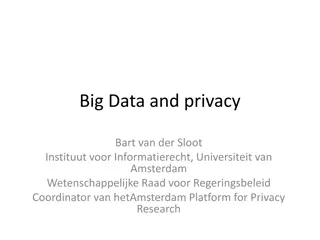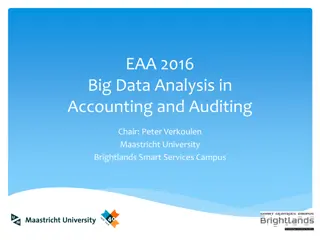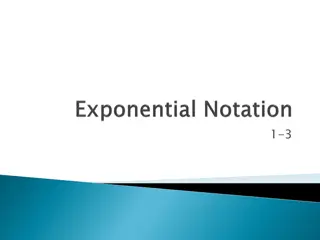Introduction to Big Data Analysis - National Taipei University Course Overview
This course at National Taipei University delves into fundamental concepts, research issues, and practical applications of Big Data Analysis. Taught by Dr. Min-Yuh Day, the syllabus covers topics such as AI, machine learning, deep learning, and industry practices related to big data analysis. Studen
6 views • 80 slides
Potential Role of Big Data in Economic Policy
Over the past two decades, there has been a significant proliferation of big data, leading to the emergence of new challenges and opportunities in economic policy formulation. The use of big data, with its three defining characteristics (volume, velocity, and variety), poses questions about the futu
3 views • 26 slides
Introduction to Basic Music Theory Concepts and Notation
Delve into the fundamental elements of music theory, exploring notation, scales, and chord progressions through visual representations. Learn how to read and interpret musical symbols, paving the way for a deeper understanding of music composition.
3 views • 13 slides
Mathematics Practice Problems - Fractions, Percentages, Scientific Notation, and Expanding Brackets
Practice various mathematics topics such as fractions, percentages, scientific notation, and expanding brackets with sample problems and solutions.
0 views • 66 slides
Pedagogical Analysis of Sets in Mathematics: Key Concepts and Teaching Strategies
Explore the pedagogical analysis of SETS by Dr. Meena Sharma, focusing on major concepts like the meaning of SET, SET notation, classification of SETS, and fundamental operations. Understand minor topics such as examples of sets, SET notation methods, and types of SETS. Objectives include defining S
0 views • 8 slides
Enemark-Feltham Notation in Iron-Nitrosyl Complexes
Iron-Nitrosyl complexes are redox non-innocent, with NO exhibiting multiple redox states. Enemark-Feltham Notation helps in determining metal-ligand interactions and oxidation states. Detailed information on NO ligands, bonding characteristics, and methods for analyzing iron-NO systems are discussed
0 views • 6 slides
Math Set Notations and Probability Practice
Practice set notation and probability with quizzes on set notation, Venn diagrams, and probability calculations based on survey results. Improve your math skills through visual exercises and calculations.
1 views • 19 slides
IP Addressing and Conversion from Binary to Decimal
Learn about IP addressing, including binary notation, dotted-decimal notation, and the process of converting binary numbers to decimal. Explore the unique features of IP addresses and the steps involved in converting binary to decimal systematically.
5 views • 47 slides
Music Notation Analysis Questions and Answers
This content provides a series of music notation analysis questions with corresponding images for practice and learning purposes. The questions cover topics such as identifying time signatures, notes, rests, intervals, keys, and specific bars with certain musical elements like ties, dotted minim, cr
0 views • 12 slides
Meet the Big Green Monster with Purple Hair and Yellow Eyes
In this playful and colorful story, encounter the big green monster with big yellow eyes, sharp white teeth in a big red mouth, a long blue nose, two little orange ears, big purple hair, and a scary green face. Despite its appearance, the monster doesn't scare the storyteller and is told to go away
0 views • 13 slides
Linear Algebra Review for Big Data Summer Institute
Join Rupam Bhattacharyya at the Big Data Summer Institute for a comprehensive review of linear algebra concepts. Explore topics such as matrix notation, special matrices, shapes of matrices, and matrix operations. Gain valuable insights for applications in big data analysis and machine learning.
0 views • 18 slides
Different Types of Constants in Programming
Constants in programming are fixed values that do not change during program execution. They include character, numerical, and string constants. Integer constants can be decimal, octal, or hexadecimal. This article explains each type of constant with examples of decimal, octal, and hexadecimal intege
0 views • 22 slides
The Benefits of Music Notation Software for Educators and Students
Discover the advantages of using music notation software in education, from enhancing creativity and exploration to facilitating composition and arrangement tasks. Learn about popular programs like Musescore, Sibelius, and GarageBand, and empower students to write music for various genres and purpos
0 views • 11 slides
Big Data and Privacy Issues in Today's Society
Explore the intersection of big data and privacy through the insights of Bart van der Sloot. Delve into current privacy issues, the application of big data, legal frameworks, recent developments, and the challenges between big data and privacy protection. Gain knowledge from interactive debates, stu
0 views • 63 slides
Mathematical Modeling for Psychiatric Diagnosis in Big Data Environment
This research project led by Prof. Kazuo Ishii aims to develop a Big Data mining method and optimized algorithms for genomic Big Data, specifically targeting three major mental disorders including depression. The research process involves data analytics, mathematical modeling, and data processing te
0 views • 21 slides
Evolution of Musical Notation Systems and Contexts
Explore the diverse world of musical notation systems, from Eastern to Western traditions, spanning Babylonian notations, Guido d'Arezzo's contributions, Gregorian chants, and modern-day tempo measures. Uncover the rich history and nuances of musical expression through various scales, staves, orname
0 views • 12 slides
Navigating the World of Big Data, Knowledge, and Crowdsourcing
The world has evolved into a data-centric landscape where managing massive amounts of data requires the convergence of big data, big knowledge, and big crowd technologies. This transformation necessitates the utilization of domain knowledge, building knowledge bases, and integrating human input thro
2 views • 5 slides
Chemistry Exam Review: Topics in Scientific Notation, Molecular Weight, Stoichiometry, and Limiting Yield
Explore key concepts in chemistry, including scientific notation, molecular weight calculations, reaction balancing, stoichiometry, and limiting yield problems. Prepare for an upcoming exam by practicing various problems and conversions related to these topics, such as expressing numbers in scientif
0 views • 4 slides
Tooth Numbering Systems in Dentistry
Dental professionals use various tooth numbering systems to identify and record teeth in the mouth. The three main systems are Universal Notation, Zsigmondy/Palmer Notation, and Federation Dentaire Internationale (FDI). Universal Notation utilizes letters for primary teeth and numbers for permanent
0 views • 19 slides
Big-Oh Notation in Time Complexity Analysis
Big-Oh notation in algorithm analysis signifies how the runtime of an algorithm grows in relation to the input size. It abstractly characterizes the worst-case time complexity, disregarding constants and lower-order terms. The concept of Big-Oh, along with Big-Omega and Big-Theta, helps in comparing
0 views • 18 slides
Privacy Risks and Opportunities in Big Data for Development
Big data presents both risks and opportunities for development initiatives, with the potential to enhance policy-making processes. While big data can improve the efficiency of public policy and administration, concerns arise regarding data accuracy, inclusivity, and transparency. Upholding privacy p
0 views • 17 slides
Big Data and Ethical Considerations in Data Analysis
Big data involves analyzing and extracting information from large and complex datasets that traditional software cannot handle. AI algorithms play a crucial role in processing big data to find patterns that humans may overlook. Ethical considerations arise in defining what is "interesting" in the da
0 views • 25 slides
An Overview of Big Data and Cloud Computing
Big data refers to vast and complex data sets difficult to process with traditional tools. Cloud computing tools like Hadoop and Spark enable the handling of big data. Types of big data include structured, unstructured, and semi-structured data. The evolution of technology, IoT devices, social media
0 views • 29 slides
Music Notation and Interpretation in KS3 Curriculum
Explore music notation in KS3 Music curriculum, focusing on reading and writing notes from E up to F on the treble clef. Understand various forms of notation such as graphic scores and enhance your musical literacy skills throughout the academic year.
0 views • 89 slides
Scientific Notation and SI Measurement Basics
Explore scientific notation as a method for expressing large and small numbers efficiently in mathematical calculations. Practice converting numbers into scientific notation and learn the rules for multiplication, division, addition, and subtraction in this format. Additionally, discover the benefit
0 views • 41 slides
EAA 2016: Big Data Analysis in Accounting and Auditing Symposium
The EAA 2016 Symposium focused on the impact of big data in accounting and auditing, featuring presentations on using data analytics to enhance audit quality, the influence of big data on management accounting research and the accounting profession. Speakers highlighted the importance of dealing wit
0 views • 4 slides
Pre-Algebra Review: Expressions and Exponents
This pre-algebra review covers topics such as evaluating expressions, working with exponents, using scientific notation, and standard form notation. Examples and answers help reinforce understanding of fundamental algebraic concepts.
0 views • 29 slides
Scientific Notation in Mathematics and Chemistry
Scientific notation is an essential concept for representing very large or very small numbers efficiently. It simplifies numbers by expressing them as a coefficient multiplied by a power of 10. This summary covers the basics of scientific notation, from converting numbers to and from scientific nota
0 views • 55 slides
Molar Mass and Avogadro's Number in Chemistry
Explore the concept of molar mass and Avogadro's number in chemistry through lessons on translating numbers into scientific notation, understanding moles, and finding molar mass on the periodic table. Discuss the relationship between mass and moles, differentiate between different quantities of a su
1 views • 11 slides
Integration of Atomic Radiation Energies and Emission Probabilities in Decay Data Sets
Proposal by Tibor Kibdi and Filip Kondev to include absolute atomic radiation energies and emission probabilities in decay data sets. They emphasize the need for energy and intensity data to be computer-readable and use standard notation. The inclusion of atomic relaxation data into ENSDF is discuss
0 views • 7 slides
Regulatory Challenges and Opportunities in Big Data Applications
Discussing the regulatory perspective on commercial versus humanitarian and development applications of big data, this conversation with regulators highlights the differences and similarities in utilizing data for various sectors. Emphasizing the importance of trust, confidentiality, and data securi
1 views • 17 slides
Exponents: Simplifying Expressions and Scientific Notation
Explore the concept of exponents, learn how to simplify expressions with negative exponents, and delve into scientific notation for efficiently representing large numbers. Discover the basics of exponents, operations involving exponents, and the application of scientific notation in various discipli
0 views • 8 slides
Exponential Notation and Evaluating Expressions with Exponents
Learn about the vocabulary related to exponential notation, how to write expressions with exponents, and how to evaluate expressions with exponents both inside and outside parentheses. Practice problems included to enhance understanding.
0 views • 17 slides
Scientific Notation: Converting, Multiplying, Dividing & More
Scientific notation is a way to express large or small numbers efficiently. Learn how to convert numbers to and from scientific notation, multiply and divide in scientific notation, and ensure proper formatting. Understand the rules for exponents and make calculations easier with these simple steps.
0 views • 8 slides
Scientific Notation and Conversions
Scientific notation is a useful way to express very large or very small numbers in a concise form. This chapter discusses how to convert numbers between scientific notation and decimal notation, providing examples and explanations for better understanding.
0 views • 18 slides
Exponents and Scientific Notation
Exponents are powers to which bases are raised, allowing for efficient representation and calculation of numbers. This review covers the basics of exponents, rules, laws, and practical applications. Scientific notation offers a method to express very large or small numbers using powers of 10. Learn
0 views • 13 slides
Set Notation and Probability in Visuals
Explore the concepts of vocabulary, set notation, Venn diagrams, probability, experiments, outcomes, sample space, events, unions, intersections, complements, and set notation through visual aids and clear explanations. Learn about subsets, empty sets, and more in this comprehensive resource from Wa
0 views • 24 slides
EM Plane-Wave Transformation Notes
In these notes by Prof. David R. Jackson for ECE 6341, the concept of EM plane-wave transformation is discussed in detail. It covers topics such as the relationship between Er and Ar, Hr and Fr, field components representation, integration formulas, and notation usage like Harrington notation. The c
0 views • 17 slides
Mastering Big Theta Notation in Computer Science
Delve into the intricacies of Big Theta notation through challenging code examples and logical puzzles. Explore concepts of algorithmic complexity, loop analysis, and closed-form expressions to enhance your problem-solving skills in computer science.
1 views • 37 slides
Big O Notation and Problem Complexity
Big O notation, Omega notation, and Theta notation are used in algorithm analysis to describe upper and lower bounds on functions. They help determine the efficiency and complexity of algorithms in terms of time and space. The content also covers examples of common computational problems like sortin
0 views • 39 slides







































